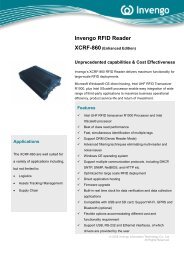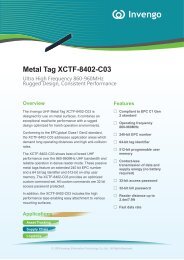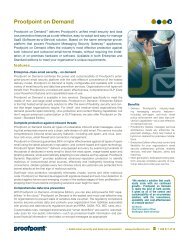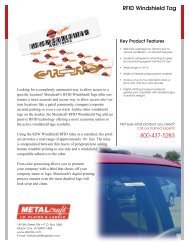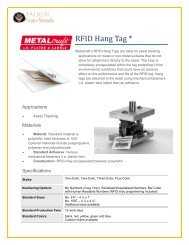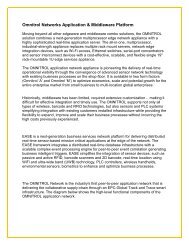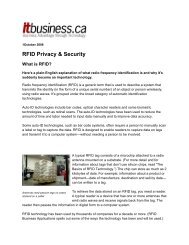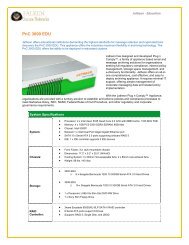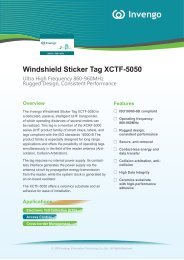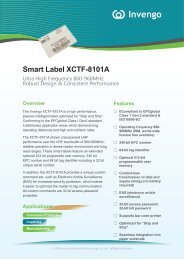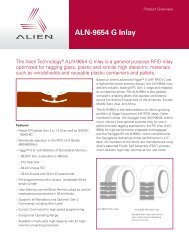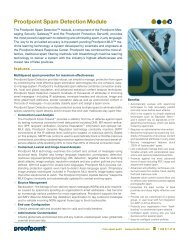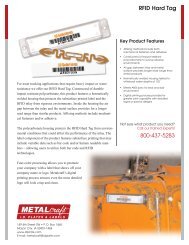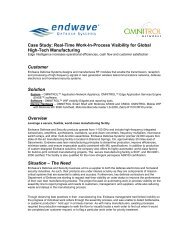The Benefits of RFID for Slab- and Coil-Logistics - Falken Secure ...
The Benefits of RFID for Slab- and Coil-Logistics - Falken Secure ...
The Benefits of RFID for Slab- and Coil-Logistics - Falken Secure ...
Create successful ePaper yourself
Turn your PDF publications into a flip-book with our unique Google optimized e-Paper software.
4_Challenges <strong>for</strong> <strong>RFID</strong> in the steel industry<br />
<strong>The</strong> previous sections have shown that<br />
there is vast potential <strong>for</strong> <strong>RFID</strong> to improve<br />
internal <strong>and</strong> external slab <strong>and</strong> coil logistics.<br />
To reap the rewards, a number <strong>of</strong> technical,<br />
economic <strong>and</strong> process challenges will have<br />
to be overcome, as is the case with the<br />
introduction <strong>of</strong> any new technology. <strong>The</strong> following<br />
topics describe these challenges <strong>and</strong><br />
suggest methods <strong>and</strong> tools <strong>for</strong> overcoming<br />
these obstacles.<br />
Radio-frequency identification readers cannot<br />
be guaranteed to communicate with all<br />
tags one hundred percent <strong>of</strong> the time.<br />
Environmental issues <strong>and</strong> inherent properties<br />
<strong>of</strong> objects being tagged impact read<br />
accuracy. <strong>The</strong> degree <strong>of</strong> concern <strong>for</strong> accuracy<br />
is directly proportional to how heavily an<br />
enterprise relies on data accuracy <strong>and</strong> how<br />
exposed it is to risk as a result <strong>of</strong> inaccuracy.<br />
Still, an absolute read accuracy <strong>of</strong> less than<br />
100 percent does not necessarily negate<br />
the usability <strong>of</strong> <strong>RFID</strong>. In industries where<br />
risk exposure is high, process redesign,<br />
in<strong>for</strong>mation auditing <strong>and</strong> redundant readers<br />
can address accuracy-related system shortcomings.<br />
4.1 Radio-frequency identification <strong>and</strong><br />
metals<br />
One <strong>of</strong> the main challenges with <strong>RFID</strong> technology<br />
is read per<strong>for</strong>mance with tagged<br />
items made primarily <strong>of</strong> metal or waterbased<br />
liquids. Metallic objects tend to<br />
reflect radio waves, which means that reading<br />
<strong>RFID</strong> tags directly applied to metal<br />
becomes extremely difficult if not impossible.<br />
Water-based liquids tend to absorb<br />
radio waves, resulting in similar read problems.<br />
A current approach to work around signal<br />
reflection places an air layer (via a layer <strong>of</strong><br />
foam or similar spacer material) between<br />
the metal item <strong>and</strong> the <strong>RFID</strong> tag. Another<br />
employs a dielectric shield (<strong>for</strong> example, a<br />
ferrite layer) to decouple the tags from the<br />
metallic object.<br />
Other options include low-frequency (LF)<br />
transponders—which because <strong>of</strong> magnetic<br />
coupling are less susceptible to detuning—<br />
<strong>and</strong> active <strong>RFID</strong>, which does not rely on<br />
radio waves from the <strong>RFID</strong>-reader to function.<br />
Some <strong>of</strong> these approaches can add significant<br />
size to a tag’s <strong>for</strong>m factor as well as an<br />
increase in cost. Others simply are not an<br />
option <strong>for</strong> use with slabs <strong>and</strong> coils as is the<br />
case with the last two examples because <strong>of</strong><br />
their very limited read range (LF technology)<br />
or size / environmental aspects (active-<br />
<strong>RFID</strong> technology).<br />
Tests conducted by ThyssenKrupp Steel <strong>and</strong><br />
Accenture have proven that passive <strong>and</strong><br />
battery-assisted tags that use the ultra-high<br />
frequency (UHF) range are best <strong>for</strong> tagging<br />
slabs <strong>and</strong> coils. <strong>The</strong>re are three options to<br />
choose from <strong>and</strong> the most appropriate one<br />
<strong>for</strong> a given application depends on the particular<br />
business case, requirements <strong>and</strong><br />
environmental context.<br />
From a hardware <strong>and</strong> air interface perspective,<br />
all three options represent a first crucial<br />
step towards st<strong>and</strong>ardization because<br />
they incorporate EPCglobal st<strong>and</strong>ards,<br />
26<br />
making them interchangeable / enabling<br />
them to co-exist within an enterprise.<br />
4.1.1 Flag-tag<br />
<strong>The</strong> so-called flag-tag is a radio-frequency<br />
identification label folded to <strong>for</strong>m a small<br />
flag st<strong>and</strong>ing just above the surface <strong>of</strong><br />
tagged objects. <strong>The</strong> short distance placed<br />
between the tag <strong>and</strong> the metal has been<br />
shown to ensure per<strong>for</strong>mance independent<br />
<strong>of</strong> the characteristics <strong>of</strong> the underlying<br />
material.<br />
Flag-tags actually function best when<br />
applied to a metallic surface, provided the<br />
<strong>RFID</strong>-inlay is placed at the right distance.<br />
<strong>The</strong>ir per<strong>for</strong>mance improvement occurs as<br />
the result <strong>of</strong> the radio waves emitted by the<br />
reader hitting the <strong>RFID</strong> tag’s antenna once<br />
be<strong>for</strong>e deflecting <strong>of</strong>f the metallic object’s<br />
surface on an angle that sends the signal to<br />
the tag a second time, thereby increasing<br />
the amount <strong>of</strong> available power to the tag’s<br />
chip. Reading distances <strong>of</strong> eight to ten<br />
meters are achievable with this solution.<br />
Design factors <strong>and</strong> a plastic coating make<br />
flag-tags flexible <strong>and</strong> relatively rugged with<br />
respect to harsh environmental conditions<br />
<strong>and</strong> mechanical stress. <strong>The</strong>y cost by far the<br />
least <strong>of</strong> the three options <strong>and</strong> have the<br />
added advantage <strong>of</strong> being able to be<br />
encoded, folded <strong>and</strong> printed on (with<br />
human-readable in<strong>for</strong>mation or / <strong>and</strong> a<br />
barcode as backup) in one step, saving<br />
valuable time <strong>and</strong> significantly reducing the<br />
risk <strong>of</strong> confusion when applied to a metallic<br />
product.



